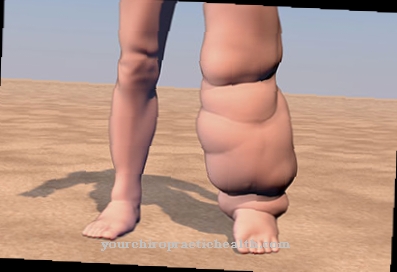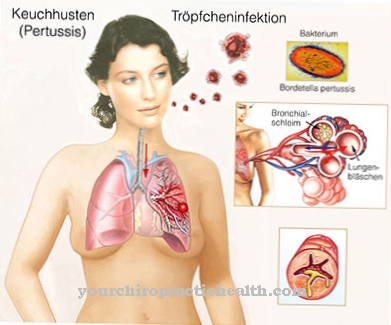Of the Pneumothorax is an accumulation of air in the space between the lungs and the chest. It leads to functional restrictions of the lungs and consequently to a lack of oxygen.
What is a pneumothorax?

© joshya - stock.adobe.com
Of a Pneumothorax one speaks when air has accumulated in the so-called pleural space. The pleural space is a narrow space between the lungs and the chest. Both the outside of the lungs and the inner wall of the chest are lined with the pleura, a thin layer of skin.
Normally there is a negative pressure between the two layers of skin, which draws the lungs to the chest and prevents them from collapsing. With a pneumothorax, air enters the pleural space and the negative pressure is released.
As a result, the lungs no longer expand together with the chest when breathing and thus absorb less oxygen. There are different degrees of pneumothorax, from a slight reduction in the tidal volume to the total collapse of the lungs, whereby only one lung or both can be affected.
causes
There are different causes for one Pneumothorax possible. Depending on the trigger, a distinction is made between idiopathic and symptomatic spontaneous pneumothorax, tension or valve pneumothorax, and traumatic pneumothorax.
In idiopathic spontaneous pneumothorax, no clear cause can be identified. What is known is that around 90% of patients are smokers and that men are more often affected than women. Idiopathic spontaneous pneumothorax is caused by a tear in the lung tissue. Symptomatic pneumothorax forms in people with pre-existing lung disease and occurs as an additional symptom. The two types described are also known as closed pneumothorax because the air entering comes from inside the body.
In contrast, the traumatic pneumothorax is one of the open forms, since air penetrates the pleural space from outside through an injury. The tension or valve pneumothorax, which is the most dangerous variant, is also called an open type. As with a valve, only air can flow in, but not out. This pneumothorax creates a lot of pressure on the lungs and heart, which causes serious circulatory disorders and can lead to a life-threatening condition.
Symptoms, ailments & signs
A pneumothorax has different symptoms depending on the severity of its severity. If only a small amount of air has entered the pleural space, the lungs will remain inflated and the patient will feel almost no discomfort. But if the lungs collapse, clear symptoms can be seen. The sudden accelerated breathing caused by the shortness of breath is typical.
The affected person begins to pant and tries to increase the air supply. In addition, there is pain in the chest, which can radiate into the shoulder. This symptom is often interpreted as a heart attack, which can make you feel very anxious. Furthermore, a dry, tickly cough can occur, which also causes pain.
If the pneumothorax is caused by an injury, skin emphysema can develop at the site of the injury; this is a clearly visible accumulation of air in the subcutaneous tissue. If a tension pneumothorax develops in the further course, the symptoms mentioned worsen and there is danger to life. The shortness of breath increases and the skin and mucous membranes turn blue due to the lack of oxygen.
The heart begins to race and only beats very flat. As the blood circulation stops working, the blood pressure drops rapidly. The blood builds up. Without treatment, the lung function will ultimately fail and the cardiovascular system will collapse.
Diagnosis & course
The symptoms of a Pneumthorax can be different. If only a little air has penetrated the pleural space, the respiratory volume is not excessively reduced and the patient hardly notices any symptoms. However, if the lungs have completely collapsed, shortness of breath occurs.
Pain occurs in the chest and stomach as well as in the heart area, radiating to the shoulder. With dangerous tension pneumothorax, the blood pressure drops extremely and the heart begins to race (tachycardia). The doctor will recognize the first signs of a pneumothorax from the symptoms. When tapping (percussion) the chest, darker knocking tones can be detected due to the increase in pressure, and when listening with a stethoscope (auscultation), changed breathing sounds can be heard.
In addition, the skin may be bluish due to lack of oxygen, the blood pressure may be low and the pulse may be higher than normal. Blood tests are used to check the level of oxygen in the blood. Another diagnostic measure is an X-ray, with which you can see the collapsed lungs and the heart and diaphragm that have been displaced by the pressure.
Complications
With a pneumothorax there is always the risk of a life-threatening complication. Whether this happens depends on its characteristics. The most dangerous complication is the tension pneumothorax. It represents an acutely life-threatening emergency that can only be remedied by immediate emergency measures.
The tension pneumothorax arises due to a thoracic injury which, via a valve action, can increase the pressure in the pleural space so much that the thoracic organs are compressed. Among other things, the heart is displaced to the opposite side and the upper and lower vena cava are squeezed. The injury acts like a lip valve, which only allows air to be drawn into the pleural space but no longer to escape.
As a result, more and more air is drawn in with each thorax movement. The tension continues to rise. The squeezing of the vena cava and the displacement of the middle layer causes increasing difficulty in breathing and leads to a drop in blood pressure. When you exhale, the chest on the affected side no longer sinks. Bulging neck veins indicate a venous congestion due to the increased pressure in the chest cavity.
Even after ventilation, the patient does not recover. In order to ensure the oxygen supply to the organism, there is a strong increase in the heart rate. Ultimately, the body can no longer be adequately supplied with oxygen. If left untreated, death occurs due to cardiac arrest.
When should you go to the doctor?
Symptoms such as sudden unilateral chest pain, irritation of the throat, or shortness of breath indicate a pneumothorax. A doctor should be consulted if the symptoms are acute and do not go away within a few minutes. Cold, damp hands, fears and pale skin indicate a tension chest, which must be checked by a doctor immediately. In the event of acute shortness of breath, intense chest pain and palpitations, an emergency doctor should be called immediately. The pulmonologist takes over the further treatment.
Depending on the symptoms and the cause of the condition, oncologists, internists and ENT doctors can also be involved. If the symptoms arise as part of a lung disease, the responsible doctor should be informed first. People who are between 55 and 65 years of age are at risk. Asthmatics, fibrosis patients and people with immunodeficiency are also among the risk groups and should see the family doctor or specialist quickly with the symptoms mentioned. This can make the diagnosis and provide rapid relief from the symptoms through medication and other therapeutic measures.
Treatment & Therapy
In the case of mild idiopathic spontaneous pneumothorax, the patient often only needs bed rest and the administration of oxygen. The air in the pleural space is mostly absorbed by the body and the normal negative pressure is restored by itself.
It takes between 2 and 4 weeks for the patient to return to normal. Since the spontaneous pneumothorax tends to repeat itself, it is possible to inject a drug into the pleural space, which sticks the two skin layers together so that no more air can penetrate. This is known as pleurodesis.
If the pneumothorax occurs as an accompanying symptom of an existing lung disease or if it was caused by an injury, a drain is often placed. A tube is inserted into the pleural space to suck out the air and restore the negative pressure.
The life-threatening tension pneumothorax requires immediate emergency treatment, in which air is released with a large cannula in order to equalize the pressure.
You can find your medication here
➔ Medication for shortness of breath and lung problemsprevention
One can be the idiopathic Pneumothorax prevent by giving up smoking. In the case of existing lung diseases, one should consult the doctor early to prevent pneumothorax as an accompanying symptom.
If the pneumothorax has been treated with drainage and then breathing difficulties or chest pain recur, the patient must contact a doctor immediately. There is a risk of respiratory failure with hypoxemia so that ventilation is required. The risk depends on the extent of the lung collapse and how long the pneumothorax lasted before drainage.
Aftercare
As part of the pneumothorax follow-up care, there are a few important things to consider for the patient. He is not allowed to stay at higher altitudes above 2,000 meters for a period of about four weeks, which is also to be considered after an operation. In addition, the affected person has to consistently take physical rest for around two to four weeks.
Normally, work can be resumed after the pneumothorax treatment, which also includes physical activity. Sports activities that involve intense physical exertion should, however, be avoided until the lungs are fully developed.
After conservative therapy, it is advisable not to fly until an x-ray has shown that the lungs have expanded completely. This can take up to six months. The check-ups are usually carried out by the family doctor. The patient is not allowed to use a wind instrument for three months after a pneumothorax. Diving is also to be avoided.
You can do that yourself
In a pneumothorax, air collects between the lungs and the chest. Breathing activity should be carried out without excitement or hectic, despite the symptoms. Fear and panic worsen the health of the person concerned and increase the existing shortness of breath.
The consumption of harmful substances such as nicotine, drugs, smoking with an e-cigarette or a water pipe must be avoided. They have a negative impact on the patient's body and breathing. Places where people smoke should be avoided as far as possible, as passive smoking can also impair breathing. In addition, rooms must be regularly supplied with sufficient oxygen. Night sleep in particular should be closely monitored. Regular ventilation leads to stuffy air being enriched with oxygen. Daily stays in the fresh air strengthen the patient and promote health. Overexertion of any kind is to be avoided. The person concerned needs rest and should not expose himself to unnecessary stress.
Physical activities should be well controlled so that they are not overwhelmed. Stress, hectic rush and conflicts are to be avoided. The excitement can make you feel less comfortable and make breathing worse. Sports activities and leisure activities must be adapted to the body's capabilities. If the person concerned notices the first irregularities, he should allow himself a break so that sufficient regeneration takes place.





.jpg)






.jpg)



.jpg)










.jpg)
